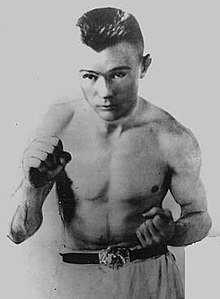Johnny Buff
| Johnny Buff | |
|---|---|
 |
|
| Statistics | |
| Real name | John Lisky |
| Nickname(s) | John Lesky Johnny Buff |
| Rated at | Bantamweight |
| Height | 5 ft 3 in (1.60 m) |
| Born |
June 12, 1888 Perth Amboy, New Jersey, U.S. |
| Died | January 14, 1955 (aged 66) East Orange, New Jersey, U.S. |
| Stance | Orthodox |
| Boxing record | |
| Total fights | 50 |
| Wins | 31 |
| Wins by KO | 14 |
| Losses | 12 |
| Draws | 3 |
| No contests | 3 |
John Lisky (June 12, 1888 – January 14, 1955), better known as Johnny Buff, was an American boxer. He was World Bantamweight Champion from 1921 to 1922. His grandsons are the modern-day boxing, wrestling and MMA announcers Michael Buffer and Bruce Buffer.
Buff was born to a family of Polish heritage on June 12, 1888, in Perth Amboy, New Jersey. He was christened John Lisky. He later took the ring name "Buff" as his friends where he grew up often called him "Buffalo". He enlisted in the Navy in 1911, at the age of 23, but did not become seriously involved in boxing until 1915, when he boxed for the Navy aboard the USS Rhode Island. He served in the Navy until roughly 1919 at the end of World War I, though he would later re-enlist.
Turning pro upon his release from the Navy around 1919, he came under the tutelage of Lew Diamond.
The most important boxing victory in his early career may have been an upset win over Johnny Rossner at the Armory in Jersey City, New Jersey, in a fairly convincing eight round newspaper win on June 23, 1919. On November 24, 1919, he first met future champion Pete Herman, fighting him to an eight-round newspaper decision at the Grand Theater in Trenton, New Jersey. He defeated Tommy Gorman at the Armory in Reading, Pennsylvania, in a second-round knockout on December 16, 1919. Gorman went down for the count after thirty seconds of fighting in the second round. Buff led noticeably in the first round landing a flurry of blows against which Buff could not defend. The final blows ending the fight came with Gorman against the ropes.
On May 31, 1920, he knocked out Willie LaMorte in the sixth of eight rounds at the Outdoor Arena in Jersey City, New Jersey. LaMorte would later contend for the NYSAC World Flyweight Title. He first fought Abe Goldstein on July 6, 1920, in New Jersey in a twelve-round, no-decision bout, where several newspapers gave him a decided edge.
On September 27, 1920, he defeated Frankie Mason at the Olympia Athletic Club in Philadelphia in an eight-round newspaper decision. Buff took the bout with a considerable points advantage. On February 11, 1921, he defeated Mason at the Tulane Auditorium in New Lorleans, Louisiana, in a fifteen-round points decision. Mason may have taken as few as two rounds in the fifteen. In the fifth round, a bad cut was opened over Mason's left eye. In their February fight, Mason was recognized as the Flyweight Champion of America by some boxing authorities.
...
Wikipedia
